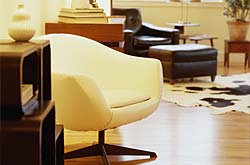Daylighting Opens Up a Window to the Home
See if We Have Top-Rated
Home Improvement Contractors in Your Area

We all have windows in our house that do their jobs: let in the light, offer a view and most importantly, keep out the cold. But are your windows living up to their full potential? This is the philosophy behind daylighting. It's not just installing windows to let the sun in. It's a highly scientific approach that examines design, architecture, climate, geography and location to fully optimize your home's natural lighting scheme.
What's the Point?
A window is just a window, right? It's supposed to be clear, clean and never leak. These qualities are important, but daylighting looks at the big picture. It contains, transfers and utilizes direct and indirect light from the sun. By strategizing the productive placement of windows and other openings in the home, you will no longer have to solely rely on electrical light. Instead, you'll let the passive energy from the sun do all the work for you. Here are some other benefits that come from natural lighting:
Solar Savings: Since you won't have to depend on fixtures anymore, your electrical costs will be slashed. Plus, taking advantage of the sun doesn't require any maintenance like most electrical fixtures (this means less burnt-out bulbs!).
Cooling Costs: Cool daylighting allows for even climate control. Just because you're using your windows for heating doesn't mean you have to bake the house in glass: instead, techniques are used to control the interior temperature. Plus, dependence on light bulbs is inefficient. They have no thermostat and so often overheat a home.
Productivity: It's been proven in schools and the work place that natural lighting makes people more productive. It's not as harsh as fluorescence and due to proper placement (usually in high areas of the home) windows aren't distracting to the eye.
Conservation: Less energy consumption always helps the environment by conserving on fossil fuels and cutting down on harmful emissions.
Be Cool: Not only does cool daylighting maintain a home's temperature, it looks cool, too—innovative design creates interesting appearances that are hip, modern and chic.
Make sure your home is designed professionally by hiring an
Interior Decorator
How Does it Work?
Daylighting doesn't just mean buying more windows. Actually, the old design rule of "less is more" applies here as well. Often, windows take on too much sun, producing glare and hot spots. So since you can't simply add more windows, lighting specialists have to use inventive design solutions to effectively use every bit of solar energy.
Placement: More is not better. Instead, think about window placement. Avoid direct contact to the home (east-west sides) and try to focus on indirect angles (north-south sides). And, to take it easy on the eyes, you actually want less light in high-traffic rooms.
Filtering: Curtains, solar shades, blinds and other treatments help to refract unwanted light at certain times of the day, cutting down on overheating and furniture/flooring fade.
Tinting: Special tints, coating and glazes are often applied over windows to help create a low-e (low-emissive) glass, blocking out unnecessary solar energy.
Reflectivity: It's not just about windows. It's also about what's on the other side. The surfaces light hits can often reflect back glare, so think about the textures in the room. Use low-gloss paint for highly-susceptible spaces and use darker shades in specific areas.
Coordination: When the sun goes down, you don't want to be left in the dark, so you have to work with your electrical lighting system as well. But if designed correctly, you'll still be able to avoid overuse: invest in controls, dimmers, and timers to slowly coordinate the natural lighting system as it transfers over to evening electrical systems.
What Does It Look Like?
Daylighting is the strategic placement of windows, but we're not just talking about picture or casement windows. Often, specialty products are used in high areas of the home in order to fully control the sun's rays. Consult with a lighting designer about the best plan for your home's layout:
High Light: Since you want to avoid direct contact from the sun, you won't have many windows at eye-level. You want to passively capture the light where it naturally arrives: the top of your house. Placing glass near the ceilings avoids excessive brightness and generates varying contact with the sun all day long.
Skylights: Skylights are a great way to maximize outdoor light. Some can be domed in order to capture an even light-level all day. Others can come with bars across them, often called light tubes, in order to defuse beams of light at the peak of the day.
Light shelves: Installed on either the exterior or interior, these awnings hang above or below windows and not only block direct contact from the sun (to avoid unnecessary glare), they also reflect light up to the ceiling, creating a dim trickle throughout a room.
More Tips & Advice For Your Home
- Related Articles
- Recent Articles

